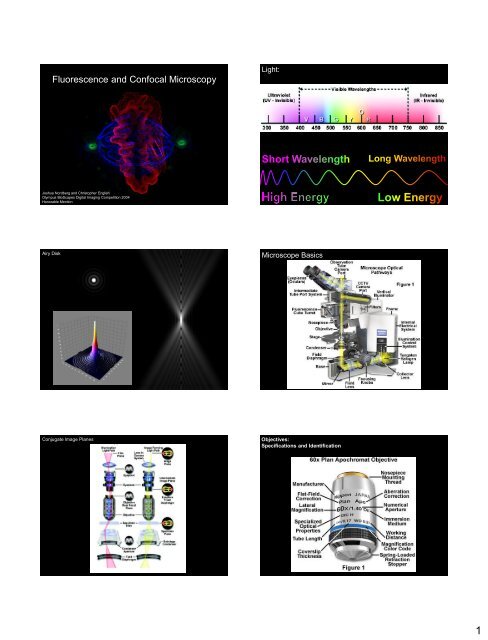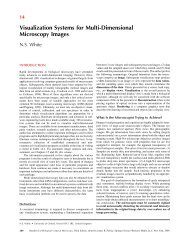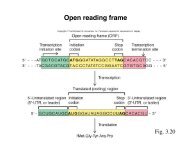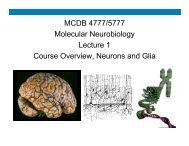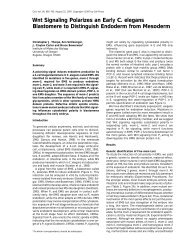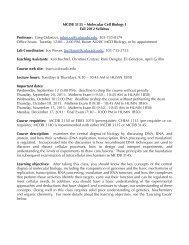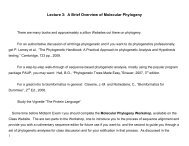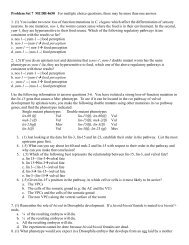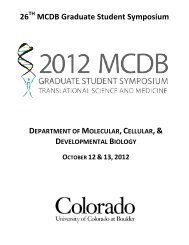Fluorescence and Confocal Microscopy
Fluorescence and Confocal Microscopy
Fluorescence and Confocal Microscopy
You also want an ePaper? Increase the reach of your titles
YUMPU automatically turns print PDFs into web optimized ePapers that Google loves.
<strong>Fluorescence</strong> <strong>and</strong> <strong>Confocal</strong> <strong>Microscopy</strong><br />
Joshua Nordberg <strong>and</strong> Christopher English<br />
Olympus BioScapes Digital Imaging Competition 2004<br />
Honorable Mention<br />
Light:<br />
Airy Disk Microscope Basics<br />
Conjugate Image Planes Objectives:<br />
Specifications <strong>and</strong> Identification<br />
1
Objectives:<br />
Chromatic Aberration<br />
Objectives:<br />
Air vs. Oil<br />
<strong>Fluorescence</strong><br />
Objectives:<br />
Numerical Apertures<br />
Mag<br />
Plan Achromat<br />
(NA)<br />
Plan Fluorite<br />
(NA)<br />
Plan Apochromat<br />
(NA)<br />
0.5x 0.025 n/a n/a<br />
1x 0.04 n/a n/a<br />
2x 0.06 n/a 0.10<br />
4x 0.10 0.13 0.20<br />
10x 0.25 0.30 0.45<br />
20x 0.40 0.50 0.75<br />
40x 0.65 0.75 0.95<br />
40x (oil) n/a 1.30 1.00<br />
60x 0.75 0.85 0.95<br />
60x (oil) n/a n/a 1.40<br />
100x (oil) 1.25 1.30 1.40<br />
Objectives:<br />
Light-Gathering Power<br />
Correction Magnification<br />
Numerical<br />
Aperture<br />
F(trans) F(epi)<br />
Plan Achromat 10x 0.25 6.25 0.39<br />
Plan Fluorite 10x 0.30 9.00 0.81<br />
Plan Apo 10x 0.45 20.2 4.10<br />
Plan Achromat 20x 0.40 4.00 0.64<br />
Plan Fluorite 20x 0.50 6.25 1.56<br />
Plan Apo 20x 0.75 14.0 7.90<br />
Plan Achromat 40x 0.65 2.64 1.11<br />
Plan Fluorite 40x 0.75 3.52 1.98<br />
Plan Apo 40x (oil) 1.30 11.0 18.0<br />
Plan Fluorite 60x 0.85 2.01 1.45<br />
Plan Apo 60x (oil) 1.40 5.4 10.6<br />
Plan Apo 100x (oil) 1.40 1.96 3.84<br />
Plan Apo 100x (oil) 1.45 2.10 4.42<br />
Plan Apo 100x (oil) 1.65 2.72 7.41<br />
Hit by High<br />
Energy Photon<br />
e -<br />
e -<br />
Ground State<br />
Excited States<br />
Emit Low<br />
Energy Photon<br />
2
• Physical Process<br />
– Excitation: S 0 + hv → S 1<br />
<strong>Fluorescence</strong><br />
– <strong>Fluorescence</strong> (emission): S 1 → S 0 + hv<br />
• S 0 is the ground state of the fluorophore<br />
• S 1 is the first excited state of the fluorophore<br />
• hν is a generic term for photon energy where:<br />
– h = Planck’s Constant<br />
– ν = Frequency of light<br />
Fluorophores<br />
Giepmans et al., 2006<br />
Green Fluorescent Protein<br />
• GFP was first cloned in 1992 from Aequorea<br />
victoria by Douglas Prasher.<br />
• Prahser also successfully expressed GFP in C.<br />
elegans in 1994.<br />
<strong>Fluorescence</strong><br />
<strong>Fluorescence</strong> Quantum Yield<br />
– the efficiency of the fluorescence process<br />
– Φ = # photons emitted<br />
# photons absorbed<br />
– The theoretical maximum fluorescence quantum<br />
yield is 1.0 (100%) where every photon absorbed<br />
results in a photon emitted.<br />
RCSB Protein Data Bank<br />
Aequorea victoria<br />
3
<strong>Fluorescence</strong> Imaging<br />
Transmitted (or Diascopic) illumination<br />
Nikon (www.microscopyu.com)<br />
Illumination Techniques<br />
• Transmitted (or Diascopic) illumination<br />
• Reflected (or Episcopic) illumination<br />
Reflected (or Episcopic) Illumination<br />
Nikon (www.microscopyu.com)<br />
Nikon (www.microscopyu.com)<br />
4
Nikon (www.microscopyu.com) Nikon (www.microscopyu.com)<br />
Widefield :<br />
Nikon (www.microscopyu.com)<br />
Widefield :<br />
Point Scanning:<br />
Point Scanning:<br />
Nikon (www.microscopyu.com)<br />
<strong>Confocal</strong> Imaging:<br />
• The invention of the confocal microscope is attributed<br />
to Marvin Minsky, who produced a working<br />
microscope in 1955.<br />
• It was developed to eliminate out-of-focus haze of<br />
fluorescent samples.<br />
5
Light<br />
Source<br />
First<br />
Pinhole<br />
Condenser Sample Objective<br />
Illumination of<br />
a Single Point<br />
Collection from<br />
the Same Point<br />
http://web.media.mit.edu/~minsky/papers/<strong>Confocal</strong>Memoir.html<br />
Second<br />
Pinhole<br />
<strong>Confocal</strong> Imaging<br />
(its all about the pinhole)<br />
Detector<br />
• Any light that passed the second pinhole struck<br />
a photomultiplier, which generated a signal that<br />
was related to the brightness of the light from the<br />
specimen.<br />
• The second pinhole prevented light originating<br />
from above or below the plane of focus in the<br />
specimen from reaching the photomultiplier.<br />
Spinning Disk <strong>Confocal</strong><br />
<strong>Confocal</strong> Imaging<br />
(its all about the pinhole)<br />
• Minsky's original configuration used a pinhole placed<br />
in front of a zirconium arc source as the point source<br />
of light.<br />
• The point of light was focused by an objective lens at<br />
the desired focal plane in the specimen, <strong>and</strong> light that<br />
passed through it was focused by a second objective<br />
lens at a second pinhole having the same focus as the<br />
first pinhole (the two were confocal).<br />
<strong>Confocal</strong> Systems:<br />
• Spinning Disk <strong>Confocal</strong> Scope<br />
• LASER Scanning <strong>Confocal</strong> Microscope<br />
– Single Photon<br />
• Fluorophores are excited by one photon of high(er)<br />
energy light<br />
– Two Photon<br />
• Fluorophores are excited by two photon of low(er)<br />
energy light<br />
Laser Scanning <strong>Confocal</strong><br />
Nikon (www.microscopyu.com)<br />
6
Controlling Image Quality:<br />
• Spinning Disk <strong>Confocal</strong> Microscope<br />
– Exposure (ms)<br />
– Gain (software)<br />
– Digitizer<br />
– EM-Gain (hardware)<br />
– Frame Averaging<br />
• LASER Scanning <strong>Confocal</strong> Microscope<br />
– Frame Size (X Pixels by Y Pixels)<br />
• Pixel Size<br />
– Scan Speed<br />
– Pinhole Size<br />
– Gain<br />
– Frame Averaging<br />
What are Digital Images<br />
• Digital images are stored using binary code (1 or 0)<br />
• Bit depth: potential grayscale pixel<br />
Monochromatic Bit Depth<br />
• 1 bit = 2 gray levels<br />
• 2 bit = 4 gray levels<br />
• 4 bit = 16 gray levels<br />
• 8 bit = 256 gray levels<br />
• 12 bit = 4,096 gray levels<br />
• 16 bit = 65,536 gray levels<br />
Color Images<br />
• 24-bit RGB images<br />
– 8-bits for each of the red, green <strong>and</strong> blue channels<br />
Noise<br />
1. Statistical Noise: R<strong>and</strong>om fluctuations in signal<br />
2. Dark (Thermal) Noise<br />
•Electrons pop out of the chip as it heats up<br />
•They build up with long exposure time<br />
•Can be reduced by cooling chip<br />
3. Read Out Noise<br />
•Errors as chip is read<br />
•Constant, regardless of exposure time<br />
•Can be reduced by reading the chip more slowly<br />
4. Camera Noise (Dark + Readout)<br />
5. Total Noise (Signal noise + Camera noise)<br />
1.25 MHz/pixel<br />
10 MHz/pixel<br />
Images collected by JWS in the Nikon Imaging Center at Harvard Medical School<br />
Digital Images:<br />
Separating Signal from Noise<br />
Ted Hinchcliffe & Kenneth Spring<br />
• Signal is defined as the change in the state of a detector produced by<br />
photons from the object of interest.<br />
• Noise is defined as meaningless fluctuations in the signal. It is of three<br />
kinds:<br />
• Optical Noise is defined as any detected photon produced by stray light<br />
from the microscope or scattered from the object of interest.<br />
• Camera Noise is defined as any change in the detector output not<br />
produced by photons from the object of interest.<br />
• Statistical Noise is defined as fluctuations in signal that arise from the<br />
r<strong>and</strong>om changes that result from inadequate sampling.<br />
Signal-to-noise ratio <strong>and</strong> its effect on image quality.<br />
7
Ways to increase the signal that the camera sees<br />
•Brighter sample<br />
•Align illumination optics (Koehler illumination) & bulb<br />
•Brighter objective lens (B = NA 4 / M 2 )<br />
•Higher transmission objective lens (less aberration correction)<br />
•Decrease specimen noise (mounting medium, BG fluorescence)<br />
•Decrease other optical noise (minimize reflective surfaces, use<br />
field diaphragm, work in dark, no dirt)<br />
Detectors: Photomultiplier Tube (PMT)<br />
Strengths: very low noise <strong>and</strong> allow rapid data collection<br />
Weaknesses: old designs don’t count every photon (GaAs PMTs, 10%<br />
efficient), but new PMTs GaAsP) are about 40% efficient at their spectral<br />
optimum.<br />
Nikon (www.microscopyu.com)<br />
A metaphore<br />
for CCD camera<br />
readout<br />
Gain:<br />
• The amount that an analog signal has been amplified. For video, gain is used to<br />
increase or decrease the dynamic range of a video camera by selecting the voltage<br />
levels that the digitizer will accept.<br />
• For example, when viewing a faint image, the gain is often raised to increase the<br />
minute changes into those that are more readily detectable.<br />
Increasing gain reduces the number of gray levels<br />
Increasing gain, Same exposure time<br />
Offset (Black Level), can be used to re-zero the gray scale<br />
Detectors: Charged Coupled Device (CCD)<br />
Images collected by JWS in the Nikon Imaging Center at Harvard Medical School<br />
The sensitivities of various electronic cameras: Video - CCD<br />
Photodiodes<br />
• A light-sensitive semi-conductor set up so<br />
incident light can knock electrons loose.<br />
• A “loose” electron leaves behind a zone of<br />
positive charge or a “hole”<br />
• Electrons <strong>and</strong> holes can move in response to<br />
an electric field<br />
• Current is then proportional to the number of<br />
“loose” electrons, i.e., to number of incident<br />
photons<br />
8
Diagram of an individual CCD “Well” or “Pixel”<br />
full well capacity<br />
on the order of ~1000 electrons/µm 2<br />
Spectral Sensitivity & QE<br />
Detector: Electron Multiplier CCD(EM-CCD)<br />
Hazelwood et al., from Shorte <strong>and</strong> Frischknecht 2007<br />
Graph from microscopyu.com<br />
Hamamatsu<br />
Improvements in Interline CCDs<br />
Single microlens added<br />
No microlens<br />
Detector: Charged Coupled Device (CCD)<br />
ORCA- ER<br />
500ms, High Gain<br />
Input<br />
light<br />
EM-CCD Performance<br />
EM-CCD<br />
200ms, Low Multiplication<br />
Open window<br />
EM-CCD<br />
200ms, Med Multiplication<br />
Microlens<br />
Image from Butch Moomaw, Hamamatsu<br />
Hamamatsu<br />
EM-CCD<br />
50ms, High Multiplication<br />
Images collected by JWS in the Nikon Imaging Center at Harvard Medical School<br />
9
Detector: Electron Multiplier CCD(EM-CCD)<br />
Dangers of Converting<br />
From 16 Bit to 8 Bit<br />
Hamamatsu<br />
Detector: Electron Multiplier CCD(EM-CCD)<br />
Nakano, 2002<br />
16 Bit 16 Bit<br />
16 Bit 16 Bit 8 Bit 8 Bit<br />
Hamamatsu<br />
10
Starting Images<br />
Ending Images<br />
16 Bit 16 Bit<br />
8 Bit 8 Bit<br />
References<br />
• Douglas C. Prasher, Virginia K. Eckenrode, William W. Ward, Frank G. Prendergast <strong>and</strong> Milton J.<br />
Cormier. Primary structure of the Aequorea victoria green-fluorescent protein. Gene. 1992 Feb<br />
15;111(2):229-33.<br />
• Chalfie M, Tu Y, Euskirchen G, Ward W, <strong>and</strong> Prasher DC. Green fluorescent protein as a<br />
marker for gene expression. Science. 1994 Feb 11;263(5148):802-5.<br />
• Giepmans BN, Adams SR, Ellisman MH, <strong>and</strong> Tsien RY. The fluorescent toolbox for assessing<br />
protein location <strong>and</strong> function. Science. 2006 Apr 14;312(5771):217-24.<br />
• Shaner NC, Campbell RE, Steinbach PA, Giepmans BN, Palmer AE, <strong>and</strong> Tsien RY. Improved<br />
monomeric red, orange <strong>and</strong> yellow fluorescent proteins derived from Discosoma sp. red<br />
fluorescent protein. Nat Biotechnol. 2004 Dec;22(12):1567-72. Epub 2004 Nov 21.<br />
• Semwogerere D. <strong>and</strong> Weeks ER. <strong>Confocal</strong> <strong>Microscopy</strong> Encyclopedia of Biomaterials <strong>and</strong><br />
Biomedical Engineering 2005 Nov. 28 10;(1-10).<br />
• Nakano A. Spinning-disk confocal microscopy - a cutting-edge tool for imaging of membrane<br />
traffic. Cell Struct Funct. 2002 Oct;27(5):349-55.<br />
• Nikon <strong>Microscopy</strong> U<br />
– http://www.microscopyu.com/index.html<br />
11


